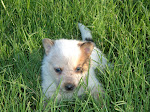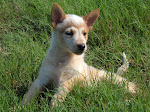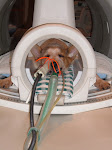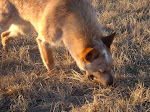- Seizures (Examination of a group of hydrocephalic Maltese dogs revealed that fewer than 20% had seizures - typically occurring within the first year of life)
- Domed skull and wide set eyes (common, but not in all cases)
- Restlessness and erratic behavior (ie. uninhibited biting, poor house training)
- Blindness (usually caused by pressure from CSF on the brain)
- Head pressing (using the head to explore, greet, bumping into things, getting stuck, etc.)
- Ataxia (incoordination)
- Compulsive circling
- Large open fontanelle (spaces closed by membranous structures between the uncompleted angles of the parietal bones and the neighboring bones of a skull)
- Weak/slow back legs, standing with limbs crossed
- Smaller than littermates
- Slow Growth
- High Stepping (walking with front legs kicking out)
- Difficulty Eating/Drinking, spitting out or being picky about food (Monitor water consumption to make sure they stay hydrated, make eating easier with small bite dry food or canned food).
Behavior problems are the most common complaint of pet owners. Most dogs exhibited erratic behavior associated with changes in their home environment or reproductive cycle. 75% are reported by their owners to be difficult or impossible to house train.
Acquired Hydrocephalus & Related Conditions: Older animals with acquired hydrocephalus more often have clinical signs that reflect abnormalities attributed to the underlying cause rather than to hydrocephalus. Complete obstruction of CSF flow causes acute onset of clinical signs as a result of loss of compensatory mechanisms (normal flow) that maintain intracranial pressure (pressure on the brain). Seizures can be a sequela (after effect, secondary result) to acquired hydrocephalus early in the disease course. Mentation (activity) often deteriorates to stupor or coma.
Other congenital conditions may be associated with hydrocephalus. The most common one is caudal occipital malformation syndrome (COMS). In people, this is called a Chiari malformation. COMS refers to a malformation of the bone at the base of the skull, resulting in pressure at the cervicomedullary junction, just as the brainstem exits the skull and becomes the cervical spinal cord. If there is compression at this site, CSF may not be able to flow normally. CSF can accumulate in the ventricles of the brain or even in the spinal cord itself (called syringomyelia). This condition is also seen most often in toy breeds (Maltese, Yorkies, Cavalier King Charles Spaniels).
Some people have compared behaviors found in Hydrocephalus patients to that of Autism. There is no proven medical link, this is simply an observation.
Other congenital conditions may be associated with hydrocephalus. The most common one is caudal occipital malformation syndrome (COMS). In people, this is called a Chiari malformation. COMS refers to a malformation of the bone at the base of the skull, resulting in pressure at the cervicomedullary junction, just as the brainstem exits the skull and becomes the cervical spinal cord. If there is compression at this site, CSF may not be able to flow normally. CSF can accumulate in the ventricles of the brain or even in the spinal cord itself (called syringomyelia). This condition is also seen most often in toy breeds (Maltese, Yorkies, Cavalier King Charles Spaniels).
Some people have compared behaviors found in Hydrocephalus patients to that of Autism. There is no proven medical link, this is simply an observation.
|
|
|
|
| Click on links below to see video of behavior/symptoms |

















No comments:
Post a Comment